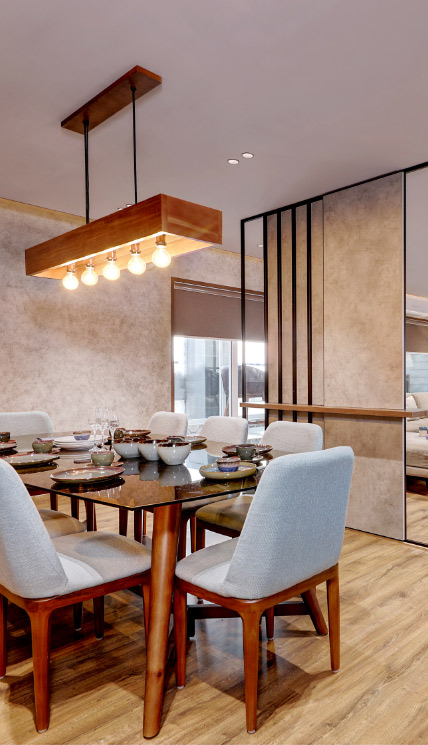Top interior design firms bring your vision to life.
Top interior design firms bring your vision to life.
Blog Article
Change Your Home With Essential Principles of Interior Decoration and Aesthetic Appeals
The art of changing your home via the crucial concepts of indoor layout and aesthetics requires a thoughtful approach that harmonizes color, equilibrium, and spatial recognition. By recognizing the influence of shade concept and the relevance of structure and patterns, one can produce areas that are not only visually enticing yet additionally deeply individual. Accomplishing this balance includes more than mere decoration; it incorporates a critical setup and an eager understanding of exactly how each aspect communicates within a space. As we discover these fundamental principles, think about exactly how they might redefine your understanding of home and individual expression.
Understanding Color Theory
Recognizing the principles of color concept permits designers to produce rooms that reverberate emotionally with passengers while meeting functional demands. Each group plays a crucial function in developing consistency within a space.
The mental influence of shades is profound; warm colors such as reds and oranges stimulate energy and warmth, while great tones like blues and environment-friendlies promote calmness and harmony. In addition, the use of complementary shades boosts aesthetic interest, creating striking contrasts that can raise a space's charm.
Neutral colors, on the other hand, function as a flexible backdrop, enabling other layout aspects to radiate. It is important to consider factors such as lighting and the area's objective when picking a shade combination, as these can change the understanding of colors throughout the day.
Ultimately, a well-considered color pattern can change an area, cultivating a feeling of convenience and style that straightens with the citizens' choices. Mastery of color theory is, as a result, a crucial ability for any kind of interior developer intending to develop unified and inviting environments.
Attaining Balance in Design
How can developers achieve a feeling of equilibrium in their rooms? Accomplishing equilibrium in style is essential to developing harmonious insides.
Unbalanced balance, on the various other hand, relies on varying components that still accomplish a natural look. This strategy allows for even more dynamic and casual setups, providing passion while maintaining balance. By thoroughly picking varying sizes, shades, and textures, designers can develop an aesthetically compelling area that really feels balanced yet energised.
Radial balance stresses a main focal factor with aspects radiating outward. This design is generally seen in circular designs, where furnishings and design produce a cohesive border that draws the eye inward.
Inevitably, attaining balance requires thoughtful consideration of scale, percentage, and the partnerships in between elements. miami luxury interior design. By masterfully using these equilibrium concepts, developers can change rooms into environments that feel both aesthetically pleasing and functionally harmonious, enhancing the general experience for residents
Significance of Spatial Understanding
:max_bytes(150000):strip_icc()/GettyImages-1161177015-f1de4ba58a6c4f50969d9119d80405a6.jpg)
An eager feeling of spatial awareness allows designers to determine centerpieces within a room, directing the audience's interest to vital attributes while keeping a total feeling of unity. It additionally assists in the strategic placement of lighting, which can significantly influence the understanding of space and mood. Recognizing spatial partnerships enables the designer to cater to the particular demands of citizens, ensuring that each area offers its intended objective without endangering appearances.
Inevitably, spatial understanding is important for making best use of the possibility of any type of interior room. By very carefully considering the interaction in between dimensions, format, and function, developers can produce environments that not just meet sensible demands but additionally evoke a sense of convenience and beauty, boosting the general living experience.
Incorporating Structure and Patterns
Accepting a varied series of appearances and patterns can substantially enhance the aesthetic and tactile allure of an interior room. The tactical usage of various products-- such as wood, steel, fabric, and rock-- creates deepness and interest, making a space really feel a lot more welcoming and dynamic. Incorporating smooth surfaces with rough textures can develop an equilibrium that attracts the eye and engages the senses.
When integrating patterns, take into consideration both scale and repeating. Big patterns can offer as prime focus, while smaller, subtle designs can complement various other elements without frustrating the area. Layering patterns, such as pairing floral cushions with candy striped throws, adds intricacy and a feeling of consistency if performed attentively.
It is additionally critical to keep a natural shade palette, guaranteeing that structures and patterns interact instead of complete for focus. By choosing a few essential textures and patterns, you can create a linked visual that shows your personal design while boosting the general atmosphere of the room. Inevitably, the mindful consolidation of these aspects can transform an ordinary area into a sophisticated setting abundant with character and warmth.
Individualizing Your Room
Developing a room that shows your character is vital to achieving an absolutely welcoming atmosphere. Personalization in indoor style allows you to instill your one-of-a-kind design and rate of interests into your home, changing it you can try these out from a simple shelter right into a shelter that talks with who you are. Begin by picking a color scheme that reverberates with your emotions-- vibrant colors can energize, while soft tones supply serenity.
Include artwork and style that reflect your interests, whether it be travel, nature, or abstract principles. Displaying individual collections, such as books, photos, or keepsakes, can evoke valued memories and create centerpieces within a space. Furthermore, consider customizing useful pieces, like upholstered furnishings, to align with your visual preferences.

Verdict
To conclude, the change of a home with the essential principles of interior decoration and visual appeal requires a thorough understanding of shade theory, balance, spatial understanding, structure, and customization. Each component adds considerably to producing an unified and useful living atmosphere - Architecture Firm. By attentively incorporating these concepts, people can enhance the visual appeal and emotional resonance of their spaces, ultimately fostering a home that reflects distinct identities while offering comfort and practicality
Report this page